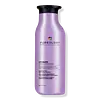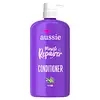What's inside
What's inside
 Key Ingredients
Key Ingredients

No key ingredients
 Benefits
Benefits

 Concerns
Concerns

 Ingredients Side-by-side
Ingredients Side-by-side

Water
Skin ConditioningSodium Cocoyl Isethionate
CleansingDisodium Laureth Sulfosuccinate
CleansingSodium Lauryl Sulfoacetate
CleansingSodium Lauroyl Taurate
CleansingSarcosine
Skin ConditioningGlycol Distearate
EmollientCocamidopropyl Betaine
CleansingGlycereth-26
HumectantDecyl Glucoside
CleansingCoconut Acid
CleansingSodium Hydroxide
BufferingSodium Isethionate
CleansingParfum
MaskingCitric Acid
BufferingPPG-5-Ceteth-20
EmulsifyingDivinyldimethicone/Dimethicone Copolymer
Sodium Chloride
MaskingPolyquaternium-7
Amodimethicone
Coco-Betaine
CleansingPolyquaternium-10
Propylene Glycol
HumectantPEG-55 Propylene Glycol Oleate
Linalool
PerfumingCarbomer
Emulsion StabilisingC11-15 Pareth-7
EmulsifyingBenzoic Acid
MaskingLaureth-9
EmulsifyingButylene Glycol
HumectantGlycerin
HumectantLimonene
PerfumingGeraniol
PerfumingTocopherol
AntioxidantBenzyl Alcohol
PerfumingTrideceth-12
EmulsifyingSalicylic Acid
MaskingSodium Benzoate
MaskingHelianthus Annuus Seed Extract
Skin ConditioningMagnesium Nitrate
C12-13 Pareth-23
CleansingC12-13 Pareth-3
EmulsifyingBenzophenone-4
UV AbsorberTetrasodium EDTA
Phenoxyethanol
PreservativeHydroxypropyltrimonium Hydrolyzed Wheat Protein
Skin ConditioningWheat Amino Acids
Skin ConditioningHydrolyzed Vegetable Protein Pg-Propyl Silanetriol
Skin ConditioningCI 60730
Cosmetic ColorantCI 60725
Cosmetic ColorantMethylchloroisothiazolinone
PreservativeHydrolyzed Soy Protein
HumectantSorbic Acid
PreservativeMagnesium Chloride
Methylisothiazolinone
PreservativePotassium Sorbate
PreservativeDisodium EDTA
Helianthus Annuus Seed Oil
EmollientAscorbic Acid
AntioxidantCamellia Sinensis Leaf Extract
AntimicrobialRosa Centifolia Flower Extract
AstringentAloe Barbadensis Leaf Extract
EmollientWater, Sodium Cocoyl Isethionate, Disodium Laureth Sulfosuccinate, Sodium Lauryl Sulfoacetate, Sodium Lauroyl Taurate, Sarcosine, Glycol Distearate, Cocamidopropyl Betaine, Glycereth-26, Decyl Glucoside, Coconut Acid, Sodium Hydroxide, Sodium Isethionate, Parfum, Citric Acid, PPG-5-Ceteth-20, Divinyldimethicone/Dimethicone Copolymer, Sodium Chloride, Polyquaternium-7, Amodimethicone, Coco-Betaine, Polyquaternium-10, Propylene Glycol, PEG-55 Propylene Glycol Oleate, Linalool, Carbomer, C11-15 Pareth-7, Benzoic Acid, Laureth-9, Butylene Glycol, Glycerin, Limonene, Geraniol, Tocopherol, Benzyl Alcohol, Trideceth-12, Salicylic Acid, Sodium Benzoate, Helianthus Annuus Seed Extract, Magnesium Nitrate, C12-13 Pareth-23, C12-13 Pareth-3, Benzophenone-4, Tetrasodium EDTA, Phenoxyethanol, Hydroxypropyltrimonium Hydrolyzed Wheat Protein, Wheat Amino Acids, Hydrolyzed Vegetable Protein Pg-Propyl Silanetriol, CI 60730, CI 60725, Methylchloroisothiazolinone, Hydrolyzed Soy Protein, Sorbic Acid, Magnesium Chloride, Methylisothiazolinone, Potassium Sorbate, Disodium EDTA, Helianthus Annuus Seed Oil, Ascorbic Acid, Camellia Sinensis Leaf Extract, Rosa Centifolia Flower Extract, Aloe Barbadensis Leaf Extract
 Reviews
Reviews

Ingredients Explained
These ingredients are found in both products.
Ingredients higher up in an ingredient list are typically present in a larger amount.
Benzyl Alcohol is most commonly used as a preservative. It also has a subtle, sweet smell. Small amounts of Benzyl Alcohol is not irritating and safe to use in skincare products. Most Benzyl Alcohol is derived from fruits such as apricots.
Benzyl Alcohol has both antibacterial and antioxidant properties. These properties help lengthen the shelf life of products. Benzyl Alcohol is a solvent and helps dissolve other ingredients. It can also improve the texture and spreadability.
Alcohol comes in many different forms. Different types of alcohol will have different effects on skin. This ingredient is an astringent alcohol.
Using high concentrations of these alcohols are drying on the skin. They may strip away your skin's natural oils and even damage your skin barrier. Astringent alcohols may also irritate skin.
Other types of astringent alcohols include:
According to the National Rosacea Society based in the US, you should be mindful of products with these alcohols in the top half of ingredients.
Any type of sanitizing product will have high amounts of alcohol to help kill bacteria and viruses.
Learn more about Benzyl AlcoholCitric Acid is an alpha hydroxy acid (AHA) naturally found in citrus fruits like oranges, lemons, and limes.
Like other AHAs, citric acid can exfoliate skin by breaking down the bonds that hold dead skin cells together. This helps reveal smoother and brighter skin underneath.
However, this exfoliating effect only happens at high concentrations (20%) which can be hard to find in cosmetic products.
Due to this, citric acid is usually included in small amounts as a pH adjuster. This helps keep products slightly more acidic and compatible with skin's natural pH.
In skincare formulas, citric acid can:
While it can provide some skin benefits, research shows lactic acid and glycolic acid are generally more effective and less irritating exfoliants.
Most citric acid used in skincare today is made by fermenting sugars (usually from molasses). This synthetic version is identical to the natural citrus form but easier to stabilize and use in formulations.
Read more about some other popular AHA's here:
Learn more about Citric AcidDisodium EDTA plays a role in making products more stable by aiding other preservatives.
It is a chelating agent, meaning it neutralizes metal ions that may be found in a product.
Disodium EDTA is a salt of edetic acid and is found to be safe in cosmetic ingredients.
Learn more about Disodium EDTAGlycerin is already naturally found in your skin. It helps moisturize and protect your skin.
A study from 2016 found glycerin to be more effective as a humectant than AHAs and hyaluronic acid.
As a humectant, it helps the skin stay hydrated by pulling moisture to your skin. The low molecular weight of glycerin allows it to pull moisture into the deeper layers of your skin.
Hydrated skin improves your skin barrier; Your skin barrier helps protect against irritants and bacteria.
Glycerin has also been found to have antimicrobial and antiviral properties. Due to these properties, glycerin is often used in wound and burn treatments.
In cosmetics, glycerin is usually derived from plants such as soybean or palm. However, it can also be sourced from animals, such as tallow or animal fat.
This ingredient is organic, colorless, odorless, and non-toxic.
Glycerin is the name for this ingredient in American English. British English uses Glycerol/Glycerine.
Learn more about GlycerinMCI is a preservative and known skin-irritant. It has anti-bacteria anti-fungal properties.
Studies spanning several decades have shown this ingredient to cause skin irritation and allergies.
MCI is commonly combined with methylisothiazolinone (MI). Other names for this mixture include Kathon CG and Euxyl K 100.
The use of this ingredient varies around the world:
Learn more about MethylchloroisothiazolinoneMI is a preservative and known skin irritant. In the past, MI was used for its ability to prevent bacteria, yeast, and fungi growth in low doses.
Nowadays, you'll most likely see MI combined with Methylchloroisothiazolinone (MCI). Trade names for this combination include Kathon CG or Euxyl K 100.
Since then, numerous studies have shown this ingredient to cause contact dermatitis, or skin irritation.
The use of this ingredient varies around the world:
Learn more about MethylisothiazolinoneParfum is a catch-all term for an ingredient or more that is used to give a scent to products.
Also called "fragrance", this ingredient can be a blend of hundreds of chemicals or plant oils. This means every product with "fragrance" or "parfum" in the ingredients list is a different mixture.
For instance, Habanolide is a proprietary trade name for a specific aroma chemical. When used as a fragrance ingredient in cosmetics, most aroma chemicals fall under the broad labeling category of “FRAGRANCE” or “PARFUM” according to EU and US regulations.
The term 'parfum' or 'fragrance' is not regulated in many countries. In many cases, it is up to the brand to define this term.
For instance, many brands choose to label themselves as "fragrance-free" because they are not using synthetic fragrances. However, their products may still contain ingredients such as essential oils that are considered a fragrance by INCI standards.
One example is Calendula flower extract. Calendula is an essential oil that still imparts a scent or 'fragrance'.
Depending on the blend, the ingredients in the mixture can cause allergies and sensitivities on the skin. Some ingredients that are known EU allergens include linalool and citronellol.
Parfum can also be used to mask or cover an unpleasant scent.
The bottom line is: not all fragrances/parfum/ingredients are created equally. If you are worried about fragrances, we recommend taking a closer look at an ingredient. And of course, we always recommend speaking with a professional.
Learn more about ParfumPhenoxyethanol is a preservative that has germicide, antimicrobial, and aromatic properties. Studies show that phenoxyethanol can prevent microbial growth. By itself, it has a scent that is similar to that of a rose.
It's often used in formulations along with Caprylyl Glycol to preserve the shelf life of products.
Water. It's the most common cosmetic ingredient of all. You'll usually see it at the top of ingredient lists, meaning that it makes up the largest part of the product.
So why is it so popular? Water most often acts as a solvent - this means that it helps dissolve other ingredients into the formulation.
You'll also recognize water as that liquid we all need to stay alive. If you see this, drink a glass of water. Stay hydrated!
Learn more about Water